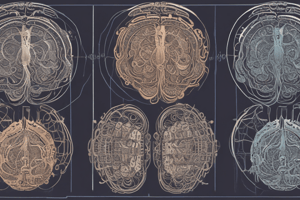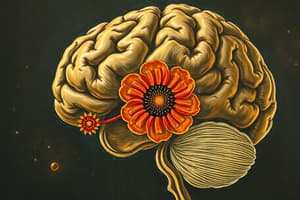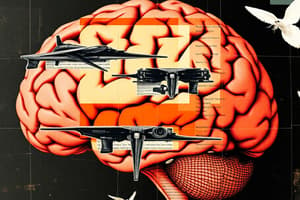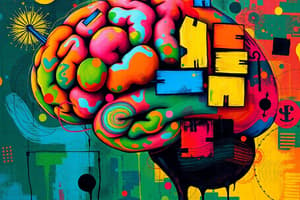Podcast
Questions and Answers
What is the function of the nodes of Ranvier?
What is the function of the nodes of Ranvier?
- To facilitate the movement of ions across the membrane
- To insulate the axonal membrane
- To allow for ion exchange between segments of the axon (correct)
- To produce action potentials
Which potential may prevent a cell from firing?
Which potential may prevent a cell from firing?
- Action potential
- Inhibitory potential (correct)
- Excitatory potential
- Resting membrane potential
What initiates the action potential in a neuron?
What initiates the action potential in a neuron?
- Release of neurotransmitters into the synaptic cleft
- Hyperpolarizing response of the membrane
- Threshold potential being reached (correct)
- Resting membrane potential reaching zero
What role do neurotransmitters play in neuronal communication?
What role do neurotransmitters play in neuronal communication?
What occurs during the hyperpolarizing response?
What occurs during the hyperpolarizing response?
Which scientist is associated with the view that the brain, not the heart, is the seat of the mind?
Which scientist is associated with the view that the brain, not the heart, is the seat of the mind?
What did Broca and Wernicke contribute to the understanding of cognitive functions?
What did Broca and Wernicke contribute to the understanding of cognitive functions?
What is the significance of the ablation experiments conducted by Flourens?
What is the significance of the ablation experiments conducted by Flourens?
What concept did Cajal introduce through his neuron mapping experiments?
What concept did Cajal introduce through his neuron mapping experiments?
How did empiricists view the understanding of mental processes compared to rationalists?
How did empiricists view the understanding of mental processes compared to rationalists?
Which term refers to the brain area's orientation towards the front?
Which term refers to the brain area's orientation towards the front?
What is the primary function of the occipital lobe?
What is the primary function of the occipital lobe?
What connects the left and right hemispheres of the brain?
What connects the left and right hemispheres of the brain?
Which type of matter consists of myelinated axons?
Which type of matter consists of myelinated axons?
Which brain structure is primarily involved in memory and spatial recognition?
Which brain structure is primarily involved in memory and spatial recognition?
What type of organization explains how opposite sides of the body are represented in the brain?
What type of organization explains how opposite sides of the body are represented in the brain?
Which lobe of the brain is responsible for processing auditory information?
Which lobe of the brain is responsible for processing auditory information?
What is the primary advantage of using single unit recording in neuroscience?
What is the primary advantage of using single unit recording in neuroscience?
What anatomical feature separates the frontal from the parietal lobe?
What anatomical feature separates the frontal from the parietal lobe?
What limitation is associated with EEG in measuring brain activity?
What limitation is associated with EEG in measuring brain activity?
Which imaging technique provides excellent spatial resolution but lacks temporal information?
Which imaging technique provides excellent spatial resolution but lacks temporal information?
How does the subtraction technique in fMRI studies function?
How does the subtraction technique in fMRI studies function?
What is the primary purpose of TMS in neuroscience research?
What is the primary purpose of TMS in neuroscience research?
What does a lesion in the brain typically indicate?
What does a lesion in the brain typically indicate?
Which of the following describes an important limitation of single dissociation in lesion studies?
Which of the following describes an important limitation of single dissociation in lesion studies?
Which imaging technique provides good spatial resolution and great temporal resolution, but is still very expensive?
Which imaging technique provides good spatial resolution and great temporal resolution, but is still very expensive?
Flashcards
Localization of function
Localization of function
The idea that different areas of the brain perform different tasks.
Distributed processing
Distributed processing
The concept that the brain works as a whole to process information.
Broca's area
Broca's area
A specific area in the brain linked to speech production.
Wernicke's area
Wernicke's area
Signup and view all the flashcards
Neuron doctrine
Neuron doctrine
Signup and view all the flashcards
Dendrites
Dendrites
Signup and view all the flashcards
Synaptic Cleft
Synaptic Cleft
Signup and view all the flashcards
Presynaptic Neuron
Presynaptic Neuron
Signup and view all the flashcards
Action Potential
Action Potential
Signup and view all the flashcards
Postsynaptic Potential
Postsynaptic Potential
Signup and view all the flashcards
Anterior/Ventral
Anterior/Ventral
Signup and view all the flashcards
Posterior/Dorsal
Posterior/Dorsal
Signup and view all the flashcards
Superior
Superior
Signup and view all the flashcards
Inferior
Inferior
Signup and view all the flashcards
Medial
Medial
Signup and view all the flashcards
Lateral
Lateral
Signup and view all the flashcards
Gyrus
Gyrus
Signup and view all the flashcards
Sulcus
Sulcus
Signup and view all the flashcards
Single-unit recording
Single-unit recording
Signup and view all the flashcards
EEG (Electroencephalogram)
EEG (Electroencephalogram)
Signup and view all the flashcards
ERP (Event-Related Potential)
ERP (Event-Related Potential)
Signup and view all the flashcards
MRI (Magnetic Resonance Imaging)
MRI (Magnetic Resonance Imaging)
Signup and view all the flashcards
fMRI (functional Magnetic Resonance Imaging)
fMRI (functional Magnetic Resonance Imaging)
Signup and view all the flashcards
MEG (Magnetoencephalography)
MEG (Magnetoencephalography)
Signup and view all the flashcards
TMS (Transcranial Magnetic Stimulation)
TMS (Transcranial Magnetic Stimulation)
Signup and view all the flashcards
Lesions
Lesions
Signup and view all the flashcards
Single Dissociation
Single Dissociation
Signup and view all the flashcards
Study Notes
Early Theories of Brain Function
- Aristotle believed the heart was the center of the mind.
- Galen believed the brain was the center of the mind.
- Willis linked brain areas to functions (incorrectly).
- Gall's phrenology was pseudoscience.
- Localization of function: different areas of the brain do different things.
- Distributed processing: the brain works together.
- Flourens' ablation experiments showed the importance of cerebral hemispheres.
- Broca and Wernicke linked specific brain areas to speech function.
- Cajal's neuron doctrine described the nervous system as made up of individual nerve cells (neurons).
Understanding Brain Activity
- Three problems about the existence of the mind are: the possibility of creating new rule-based sentences, the possibility of studying mental processes with mri and other similar technologies and the fact humans can study themselves via introspection.
- Cognitive Psychology view: perception, attention, memory, language and thinking.
- Dendrites receive messages from other neurons.
- Nodes of Ranvier are short regions of axon membrane without myelin.
- Ion channels move ions across axon membranes.
- An action potential causes local changes in ion concentration that travels down the axon to send messages.
- Neurons aren't physically connected; they communicate via neurotransmitters across a synapse.
- The synaptic cleft is the gap between neurons.
- A neurotransmitter is a chemical messenger.
- Synapses are junctions between neurons where neurotransmitters are released.
- Presynaptic cells transmit signals, postsynaptic cells receive signals.
- Steps of neurotransmission: action potential, neurotransmitter release, neurotransmitter binding to receptors, ion flow, postsynaptic potential, excitatory/inhibitory potential.
- Resting membrane potential is the voltage difference across the membrane at rest.
- Hyperpolarizing response makes the membrane more negative.
- Depolarizing response makes the membrane more positive.
- Threshold potential triggers action potential.
- Refractory period prevents immediate re-excitation
- All-or-nothing principle: A neuron either fires or it doesn't resulting from a specific chemical process.
- Directionality terms: anterior/ventral, posterior/dorsal, superior, inferior, medial, lateral, rostral, caudal
- Planes of section: coronal, sagittal, horizontal
Brain Structures
- Surface anatomy: gyri (ridges), sulci (grooves), fissures (deep sulci).
- Grey matter: cell bodies, dendrites, synapses.
- White matter: myelinated axons.
- Structures: cerebellum (motor skills), brain stem, cerebrum (cognitive functions).
- Four lobes of cerebral cortex: frontal, parietal, temporal, occipital.
- Frontal lobe: reasoning, social behaviour, language production.
- Parietal lobe: spatial awareness, navigation, perception.
- Temporal lobe: auditory processing, high-level visual processing, language comprehension.
- Occipital lobe: visual processing.
- Association cortex: integrates information across sensory modalities.
Recording and Studying Brain Activity
- Localization of function is tested by studying the affect of brain lesions on cognitive abilities.
- Contralateralization is opposed to ipsilateral signaling, with different body regions in the brain being controlled by different parts of the body on the opposite side.
- Different parts of the brain have different topographic organization.
- The nervous system shows topographic organization and contralateralization.
- Spatial organization in the body regions in the brain are connected proportionally to their sensitivity.
- Thalamus relays sensory information.
- Basal ganglia is involved in movement, conditioning, emotion.
- Hippocampus relates to memory and spatial awareness.
- Amygdala handles emotional response and regulation.
- EEG (electroencephalography): measures electrical activity; poor spatial, good temporal resolution.
- ERP (event-related potentials): averages EEG data to isolate responses to specific events; decent spatial, good temporal.
- MEG (magnetoencephalography): measures magnetic fields; decent spatial, good temporal.
- fMRI (functional magnetic resonance imaging): measures blood flow; excellent spatial, poor temporal.
- TMS (transcranial magnetic stimulation): non-invasive way to stimulate or suppress brain activity; high spatial and temporal.
- Lesion studies and methods of studying brain damage.
- Single dissociation and double dissociation.
- Plasticity in some brain regions allows compensation for lesions.
Studying That Suits You
Use AI to generate personalized quizzes and flashcards to suit your learning preferences.




